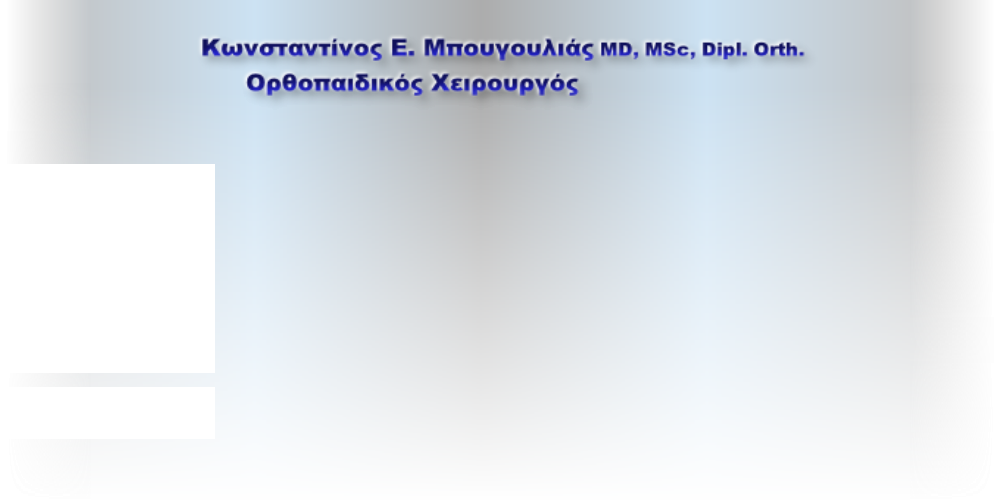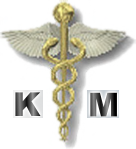


Κωνσταντίνος
Ορθοπαιδικός
Bougoulias.com | © 2022 | All rights reserved
Μπουγουλιάς
Χειρουργός





The latest HTML5, CSS3 and advanced JavaScript have
been used to ensure the highest compatibility.




MSc in Sports and Exercise Medicine, UCL
Sports, Exercise and Health module
Essay: “13 years old male footballer who is experiencing anterior knee pain for the last 4 months not associated with traumatic incidents. Pain is worse after playing and mainly located over the proximal tibia diagnosed as Osgood Schlatter disease”
Konstantinos Bougoulias
Patient initially presented with a history of left knee pain for 4 months. He denied any obvious history of trauma, but he claimed to play a lot of football and felt that the pain was worse after the game. Patient also claimed to have a “knot” over the anterior aspect of his proximal tibia. On physical examination the patient had a prominent tibial tubercle which was swollen and tender. The knee did not have an effusion and there was no joint tenderness. There was also no tenderness over the patellar tendon. There was full range of motion in the knee, but the patient had hamstring tightness. He also had pain with resisted knee extension. There was no instability to varus or valgus stress. McMurray and Lanchman tests were negative. Patellar tracking was normal and there was no pain with loading of patellofemoral joint. Xray of the knee revealed an ossicle anterior to the tibial tuberosity. Patient was diagnosed with Osgood-
Osgood-
The disease originally described simultaneously by Osgood and Schlatter in 1903.
Typically develops in girls between the ages of 8 and 13 and in boys between 10 and 15 at the beginning of their growth spurt ( Krause et al 1990). Kujala et al (1985) put the prevalence of the condition in athletic adolescents at 21%, as compared with 4.5% in age-
Etiology
Most commonly accepted: microavulsions caused by repeated traction on anterior portion of developing ossification center of tibial tuberosity. Inflammation and reparative changes cause pain, swelling, tenderness.
Rosenberg et al (1992) with an MRI/CT study, claimed that tendonitis may be as important as apophysitis.
History and physical examination
Diagnosis is usually straightforward. Patients often point to the tibial tubercle as the source of their anterior knee pain and many also complain of swelling and prominence over the tubercle. The pain generally occurs during activity and remits with rest. Its onset is insidious and the patient typically cannot identify an acute traumatic cause. Severity can be roughly described in terms of three grades, depending on the duration of pain
Grade Characteristics
1 Pain after activity that resolves within 24 hours
2 Pain during and after activity that does not limit activity and resolves within 24 hours
3 Constant pain that limits sports and daily activity
(Blazina et al 1973)
On examination, knee tenderness is very well localized over the tibial tubercle. The patient usually has full range of motion with no effusion or instability and no meniscal signs. To exclude other conditions, the physical examination should also include an assessment of range of motion at the hip and palpation of the inferior pole of the patella.
Imaging Studies
If the history and physical examination indicate Osgood Schlatter Disease at an adolescent’s initial visit to a primary care physician, radiographs are not required. Radiographs can be normal, or they can show irregular ossification of the tibial tubercle, but this can be a normal variant in asymptomatic adolescents. For patients who had an acute onset of pain, radiographs should be obtained to rule out an avulsion fracture of the tibial tubercle. For patients with night pain , other non-
Ultrasound and MRI scans can confirm the diagnosis of Osgood-
Differential Diagnosis
Other causes of chronic anterior knee pain include Sinding-
Sinding-
Patellofemoral syndrome probably arises from repetitive stress of the patella on the femur. Pain is elicited with light manual pressure by rubbing on the patella with a side to side motion.
The diagnosis of osteochondritis dissecans is usually made by radiographs because there is no reliable clinical test.
Hip range of motion should be assessed in any adolescent with knee pain; limitation of, or pain with, internal rotation should prompt radiographic studies to rule out a slipped capital femoral epiphysis and Perthes’ disease.
The history may suggest a need for radiography to rule out an avulsion fracture of the tibial tubercle, a tumor or an infection.
Treatment
Treatment depends on the severity of the condition.
Grade 1 and 2
Many patients with grade 1 and 2 symptoms (pain that lasts no more than 24 hours after activity) and their parents may only need reassurance that the condition is usually self limiting and that is not a tumor. Patients can play sports as long as pain is tolerated and resolves within 24 hours. When symptoms flare up, short term rest from the offending activity typically eliminates pain. Total rest is not recommended as it can lead to deconditioning and increase the chance of recurrence with return to sports. Shock absorbent insoles in sports shoes may decrease peak stress on the tendon and tuberosity. Icing may be beneficial. Hamstring and quadriceps stretching is recommended by most authors. Pddind of the tibial tubercle can help. Anti-
Grade 3
Osgood Schlatter disease at this grade (constant pain that limits daily activity and sports performance) warrants more intensive treatment. Rarely, a 3 to 4 week course of immobilization with a cast or brace is indicated for severe recurrent disease that has resisted the first line treatment. In the adolescent population, immobilization is often required to enforce the physician’s recommendation of rest. The routine use of casting does not seem to alter the natural history (Krause et al 1990).After rest or immobilization, patients can start a rehabilitation program.
In a recent study (Badelon 1996) of athletes with resistant grade 3 Osgood Schlatter disease, a dual hinged knee brace that limited motion to between 0 and 40 degrees allowed the athletes to return to sports with immediate cessation of pain. These findings should be considered preliminary, however, since the study involved only six patients and had no control group.
Educate and Moderate
Osgood Schlatter disease is one of the common causes of adolescent knee pain. A lot of young athletes’ careers have been destroyed because of bad management. Mild symptoms require only patient education and activity moderation. Athletes with severe symptoms may benefit from rest, short term immobilization, followed by aggressive rehabilitation program.
References:
Badelon O: Knee-
Severe chronic articular cartilage and Osgood-
Diseases, abstracted. Pediatric Orthopaedic Society of North
America, annual meeting program 1996, p 117
Blazina ME, Kerlan RK, Jobe FW, et al: Jumper’s knee.
Orthop Clin North Am 1973;4(3):665-
Krause, et al: Natural History of Osgood Schlatter Disease.
JPO 10:65, 1990
Kujala et al: Osgood-
Micheli L: Pediatric and Adolescent Sports Medicine, in Griffin LY (ed): Orthopaedic Surgeons, 1994, pp349-
Rosenberg, et al: Osgood Schlatter Lesion: Fracture or Tendinitis? CT and MR. Imaging features. Radiology 185:853, 1992
London 2004
